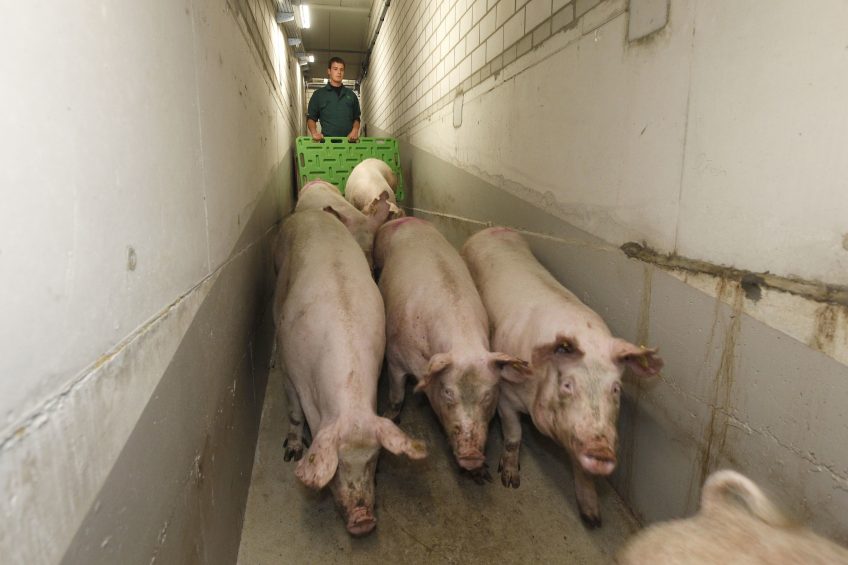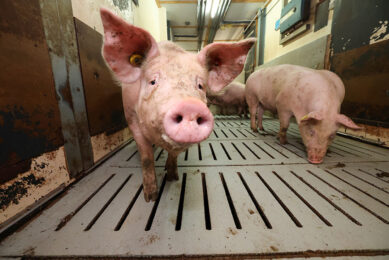Correct layouts when moving pigs manually

Moving pigs can be quite a nuisance if the animals don’t cooperate, pig management expert John Gadd wrote in a previous contribution. Techniques however exist to make your life easy, he says. Here he discusses the manual method – with plenty of inspiration from Dr Temple Grandin.
In my previous article I drew together several useful ‘do’s’ and ‘don’ts’ when having to move pigs. In this follow-up piece I suggest some layouts when needing to weigh pigs in what I suppose we have to call the existing ‘manual method’ we use now, as the new technique of weighing by tomography is now with us and will eventually take over.
But that will be some years away on the typical farm, so some observations on present methods are appropriate.
Dr Temple Grandin – an extraordinary behaviourist
20 years or so ago I was fortunate to spend some time at the feet of this extraordinary animal behaviourist. Her speciality at the time was how cattle react to humans. Subsequently her research and particular synergy and empathy has spread to other species, including pigs.
Unconventional maybe, sometimes outspoken as she is, but she has always talked a great deal of sense and, impressed by her findings and advice, I have applied some of them to my clients’ farms over the years. Let’s look at some of her opinions.
‘Jamming’ before entering a weigh crate
Jamming before entering a weigh crate is often a nuisance, especially when too big a group of pigs, gilts or growing stock, are held ready for treatment (2 smaller groups gain entry quicker in the end than a more convenient large one).
As Figure 1 shows, a treatment crate is best angled to the line of entry so as to discourage the to-be-weighed pigs from being concerned about what may be happening ahead and reluctant to move onwards. This is because the angled crate and what is going on ahead is away from the next pigs direct line of sight and the reluctance to move forwards is reduced.
Figure 1 – Treatment/weighscales chute with entrance to prevent jamming at the chute entrance. The angled fences at the rear gate eliminate corners in which the pigs could bunch up. The exit chute is angled to prevent incoming pigs from seeing the scales and balking.
Pairs of pigs encourage confidence
Another Grandin observation – 2 in fact. The 1st is that pairs of pigs move more readily forwards than just one by itself. Provided that the design of the race separates the 2 physically but not visually, as in Figure 2, otherwise they can jam each other.
Figure 2 – Two chutes side by side are better than one. The outer sides should be solid to prevent the pigs from seeing distractions outside the chute. The centre partition should be constructed so the pigs can see each other in the adjacent chute. This encourages following behaviour and improves the flow of hogs.
This can be incorporated into any loading ramp and the design of hers is shown in Figure 3. A benefit for the stockperson from this layout is that the process of loading can be controlled from one static position from which he/she never needs to move, which saves time and effort.
Figure 3 – A loading ramp with two single-file chutes. The handler stands at ‘1’, when the crowding pen is full and directs the leaders into the chutes. As the pen empties, the handler steps through the gate into position ‘2’ and swings the gate around.
The narrowed footwell for propelling pigs
Her 2nd idea is the narrowing of the footwell (again, see Figure 2). This helps propel the pigs forwards up even a steep loading ramp. Prof Grandin found that if you narrow the natural standing stance (i.e. the normal distance apart of the pigs feet) by 10-15%, done by inserting ‘vee-blocks’ down each side of the race, then when the pig starts walking, it tends to tip forwards slightly off-balance, which it instinctively corrects by taking an involuntary step forward.
Find more expert opinions at the website of Pig Progress
Several of my clients have to move sows quite a distance, sometimes outside, from one building to another, and of course need to set up a railed passage across the concrete. Of course being sows, some tend to stop and explore and have to be tapped onwards from holding up those behind them – always a nuisance.
With the narrowed footwell idea inserted into the foot of the race, it can be quite amusing to see the whole chain trotting forwards like clockwork.














